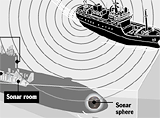 Passengers' hands were on sub controls Passengers' hands were on sub controls
 Collision to be focus of Navy's inquiry Collision to be focus of Navy's inquiry
 Calling off search to yield endless grief Calling off search to yield endless grief
 Civilian sub guests strictly supervised Civilian sub guests strictly supervised
 Sub crash happened outside training area Sub crash happened outside training area
 Tribute to the Missing Tribute to the Missing
 Previous stories Previous stories
By David Waite
and Tim Hurley
Advertiser Staff Writers
More than 10 years ago, the National Transportation Safety Board urged the Navy to require surfacing submarines to use active sonar in hopes of avoiding collisions such as the one that occurred between the USS Greeneville and a Japanese training ship off O‘ahu.
Navy officials have acknowledged that the Greeneville used only its passive sonar — not active sonar as recommended by the NTSB more than a decade ago — in the minutes before it burst to the surface and sliced through the hull of the Ehime Maru.
NTSB investigator John Hammerschmidt said Greeneville crew members on Tuesday confirmed that "at least a passive-sonar check" was done before the sub began the rapid ascent that carried it directly beneath the Ehime Maru.
He said he was told "there might have been problems" associated with using active sonar, but he did not elaborate.
Hammerschmidt said he had not concluded whether the accident would have been avoided if the Navy had followed the 1990 NTSB recommendation that surfacing submarines use active sonar except in cases where national security would be compromised.
"That calls for analysis and conclusion, and we are still in the very early stages — the information-gathering stage — of our investigation," Hammerschmidt said.
The NTSB’s active-sonar recommendation grew out of its investigation of a June 1989 incident in which the USS Houston, an attack submarine, snagged a tugboat’s submerged tow cable with its communications mast.
The snagged cable dragged down the stern of the tug, eventually sinking it. The tug had been towing two empty barges between San Pedro, Calif., and Catalina Island. One tug crewman drowned and two others survived.
NTSB investigators concluded that the Houston’s crew might have been able to tell that the tug was towing two barges if it had been using active sonar.
But because it was using only passive sonar, it could not detect the two empty barges or the tow cable, gliding almost silently through the water.
In a letter dated Nov. 19, 1990, Rear Adm. R.G. Jones rejected the NTSB’s active-sonar recommendation, saying that rather than having its use dictated in specified situations, the determination whether to use it should be left up to officers aboard individual submarines, "given the tactical situation."
The NTSB, which can make recommendations but lacks authority to force their adoption, took the matter to Adm. Frank B. Kelso II in April 1991.
Then-NTSB Chairman James Kolstad told Kelso that "in light of the Houston’s mission and location at the time of the incident, it appears unlikely that the (Houston’s) detection would have compromised its security.
"Moreover, the accident demonstrated that a passive search was not sufficient to ensure safe navigation of the submarine."
Kolstad said the NTSB was closing the matter and classifying the Navy’s response "unacceptable."
Sonar, an acronym for sound navigation and ranging, is a detection system based on the reflection of underwater sound waves, just as radar is based on the reflection of radio waves in the air.
A typical sonar system emits ultrasonic pulses and listens with a sensitive microphone, or hydrophone, for reflected pulses from potential obstacles or other vessels.
When using active sonar, a submarine transmits a pulse of sound into the water, typical of the "ping" heard on TV shows and in movies about submarines, then listens for how long it takes to bounce off an object and return, giving information about the object’s direction and distance.
When a submarine uses active sonar, all the other sonar-capable ships and submarines in the area are able to detect the submarine’s presence. Since stealth is the primary advantage submarines enjoy, active sonar is rarely used.
Passive sonar, in use since World War II, listens for sounds coming from other ships and submarines from miles away without revealing its own position. Computers filter out noise and adjust for environmental factors, such as water temperature, to translate what is being received.
John P. Craven, University of Hawai‘i professor emeritus of ocean engineering and law, said that if the Greeneville crew used its active sonar before surfacing, the fishing vessel likely would have been detected.
Craven, a former chief scientist of the Navy’s special projects office, said that while passive sonar should have picked up the engines of the fishing vessel, it is less accurate at short-range detection than active sonar, which he described as having "magnificent precision."
The submarine apparently was following Navy protocol in using only passive sonar during an emergency surfacing drill that preceded the collision with the Ehime Maru. But, Craven said, the Navy should have required use of the active sonar as well.
"The ocean rewards you if you do the right thing. If you make a mistake, it will kill you," he said. "The sea will teach you a lesson you did not want to learn."
In the hours immediately after the Ehime Maru sank, Navy officials theorized that the fishing vessel may have been sitting dead in the water, generating no engine or propeller noise that would have alerted the Greeneville’s sonar technicians.
But the Ehime Maru’s captain, who survived the sinking, has said his ship was under power, traveling at 11 knots (about 13 mph), when the collision occurred.
In response to questions yesterday about the submarine’s use of sonar, Rear Adm. Craig Quigley, a Pentagon spokesman, insisted that passive sonar, not active, was the right choice for the Greeneville under the circumstances.
Advertiser Washington Bureau reporter Susan Roth contributed to this report.
[back to top] |

